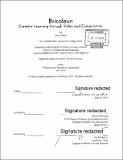| dc.contributor.advisor | Mitchel Resnick. | en_US |
| dc.contributor.author | Hickey, Sean(Sean Michael) | en_US |
| dc.contributor.other | Program in Media Arts and Sciences (Massachusetts Institute of Technology) | en_US |
| dc.date.accessioned | 2020-01-23T17:02:02Z | |
| dc.date.available | 2020-01-23T17:02:02Z | |
| dc.date.copyright | 2019 | en_US |
| dc.date.issued | 2019 | en_US |
| dc.identifier.uri | https://hdl.handle.net/1721.1/123639 | |
| dc.description | Thesis: S.M., Massachusetts Institute of Technology, School of Architecture and Planning, Program in Media Arts and Sciences, 2019 | en_US |
| dc.description | Cataloged from PDF version of thesis. | en_US |
| dc.description | Includes bibliographical references (page 115). | en_US |
| dc.description.abstract | In his theory of constructionism, Seymour Papert asserted the importance of bricolage in the learning process. Papert defined bricolage as "a style of organizing work that can be described as negotiational rather than planned in advance." The bricoleur - one who engages in bricolage - works in dialogue with their materials, continuously experimenting and course-correcting as necessary. Throughout this process, the bricoleur creates relations between materials and in doing so, builds mental relations in their head among ideas and knowledge. In this sense, creating with materials is the thinking process and as a result, Papert claimed that "in the most fundamental sense, we, as learners, are all bricoleurs." In light of this, it is important to develop rich bricolage contexts and experiences to support learners in constructing their own knowledge. This thesis describes Bricoleur, a new tool for creating expressive projects in a bricolage style. Bricoleur builds off of the programming paradigm developed for the Scratch programming language to allow makers to create a wide variety of dynamic projects by capturing and programming video and audio media on tablet hardware. We describe the design decisions that led to the creation of a tinkerable tool that engages both the mind and body. In addition, we outline the types of projects and working styles that emerged during creative workshops in which makers created projects with Bricoleur. We then look at some broad outcomes of the work, noting that Bricoleur enables young makers to engage not just with computation and media, but also with their bodies, their environment, and the people around them. Through this process, makers encounter ideas about space, place, people, and time. We conclude with some reflections on future directions for the tool, mobile programming in general, and new possibilities of creative contexts for bricolage. | en_US |
| dc.description.statementofresponsibility | by Sean Hickey. | en_US |
| dc.format.extent | 115 pages | en_US |
| dc.language.iso | eng | en_US |
| dc.publisher | Massachusetts Institute of Technology | en_US |
| dc.rights | MIT theses are protected by copyright. They may be viewed, downloaded, or printed from this source but further reproduction or distribution in any format is prohibited without written permission. | en_US |
| dc.rights.uri | http://dspace.mit.edu/handle/1721.1/7582 | en_US |
| dc.subject | Program in Media Arts and Sciences | en_US |
| dc.title | Bricoleur : creative learning through video and computation | en_US |
| dc.title.alternative | Creative learning through video and computation | en_US |
| dc.type | Thesis | en_US |
| dc.description.degree | S.M. | en_US |
| dc.contributor.department | Program in Media Arts and Sciences (Massachusetts Institute of Technology) | en_US |
| dc.identifier.oclc | 1136610866 | en_US |
| dc.description.collection | S.M. Massachusetts Institute of Technology, School of Architecture and Planning, Program in Media Arts and Sciences | en_US |
| dspace.imported | 2020-01-23T17:02:02Z | en_US |
| mit.thesis.degree | Master | en_US |
| mit.thesis.department | Media | en_US |
